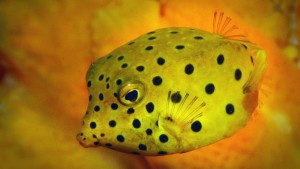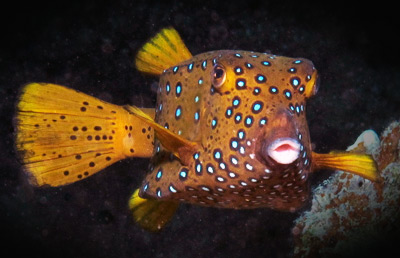For hobbyists inclined to purchase livestock on impulse, a yellow boxfish (Ostracion cubicus) paddling about in a dealer’s tank can prove almost irresistible. Typically sold as juveniles at just a few inches in length, these boxfish are as cute as can be, and their interesting shape and garish coloration really make them stand out among other species offered for sale.
Unfortunately, that cuteness and bright coloration are fleeting, and too many impulsive hobbyists who succumb to the siren song of O. cubicus soon discover that they’ve bitten off more than they can chew with this species.
Physical traits
As its common name implies, O. cubicus has a vaguely box-shaped body, a pointed snout, and high-set eyes—picture a somewhat squared-off pufferfish, and you’ll get the gist. Juveniles are bright yellow with dark-brown polka dots. However, as specimens age, the bright yellow gives way to a more subdued brownish yellow. Also, it’s important to understand that those tiny, adorable juvenile specimens in dealers’ tanks have the potential to reach upwards of 18 inches.
Toxic nature
A much bigger consideration when it comes to keeping O. cubicus in aquariums is this species’ ability to exude a deadly toxin, called ostracitoxin, when stressed. If released, this poison can kill all the fish in the tank, including the boxfish. The likelihood of such an event shouldn’t be overstated, but it can and does happen.
Feeding
O. cubicus is omnivorous, feeding on algae and a range of small invertebrate prey items. Specimens kept in aquariums should be offered a variety of small or chopped meaty seafoods along with marine-algae-based formulations. Be aware, however, that specimens may be slow to accept foods offered in captivity and live foods may be needed initially to elicit a feeding response. Multiple daily feedings are recommended.
Housing
Don’t let this species’ usually tiny sale size lull you into thinking it’s a good candidate for smaller systems. It most decidedly is not! Plan on a tank of at least 125 gallons to accommodate an adult yellow boxfish, and be sure to allow plenty of open swimming space in addition to suitably sized hidey holes. Furthermore, the tank should be placed where excessive human activity and other external stressors aren’t likely to be an issue.
Given this species’ toxic tendencies and intolerance of poor water conditions, robust protein skimming, chemical filtration, and regular water changes are a must. I would also recommend keeping a relatively large supply of clean, heated, and aerated salt water (with parameters matching those of your display tank) on hand at all times. That way, if you do suspect ostracitoxin has been released, you can perform a massive water change immediately—or even move the fish from your display tank to the vessel of clean water in an emergency.
Tankmates
Again, stress can lead to ostracitoxin release, so any tankmates kept with O. cubicus must be non-aggressive and non-boisterous. The best bet might be to give this species a dedicated tank all to itself.
Though it may not be a direct threat to corals and other sessile invertebrates (aside from tubeworms), I would not recommend including O. cubicus in a reef system, owing to its relatively large adult size, demand for frequent feedings, and copious waste production.




